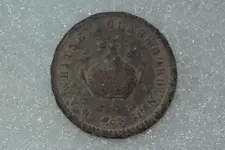During various periods in our history, shortages of small change happened. This was most often due to the price of metals exceeding the face value of the coins. That promptly drives coins out of circulation - why spend a cent that could bring 1.1 cents at the scrap metal dealer? That is why the Mint has made many changes in composition of coins over the years. In 1852, the large US one-cent piece was on its way out - it was expensive to make and unpopular - 1857 saw the last mintage of them. The small cent was introduced in 1856 and was considerably smaller. It was made of a copper-nickel alloy rather than pure copper.
Another thing to consider was that Spanish, Mexican, and other foreign coins circulated alongside the US Mint products until 1857 when we officially converted to our decimal system of dollars and cents. While all this was going on, businesses were having a hard time conducting business because of the shortage of small coins. Keeping in mind that one cent in the 1850s was a significant amount, compared to the value of a cent today, consider the business' plight when a customer came in with a five-cent piece and bought a one-cent item. They either had to pass up a sale because they did not have four cents to give the customer in change, or come up with another solution. Many enterprising businesses did just what S. A. Whitney did - they had their own one-cent pieces made. These tokens were usually made of brass which was cheaper than copper, and they tended to circulate in the general area of the issuer. They could even be a profit-maker for the business as the only way they could be redeemed is through another sale. Or, if they were lost, they were never redeemed and the business had gotten one cent (less, of course, the cost of manufacture). Plus, they served as advertising of the business in the community and showed the public that the business was doing its part to relieve the shortage of coins.
Later tokens, the so-called "good for" tokens, served much the same purpose, but usually with an added twist. It could be that they were used for gambling where gambling for money was illegal. Or, in the case of a general store, they were used to give loans to customers while keeping the customer's business at that store. There are many of these added twists, and tokens served many different purposes, so the study of them is very educational.
John in ID









 but what would the token have been used for. I have seen many different tokens on this site, but not sure how they were used.
but what would the token have been used for. I have seen many different tokens on this site, but not sure how they were used.